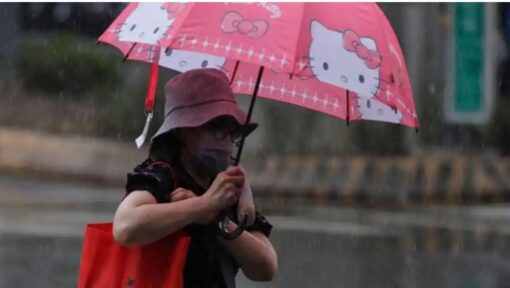China is on high alert as Typhoon Ragasa, one of the strongest storms to threaten the country in years, barrels toward its southeastern coast.
The government has canceled schools, grounded flights, and issued sweeping evacuation orders as authorities brace for what could be a devastating landfall.
Officials say the China Typhoon Ragasa emergency is already disrupting the lives of millions and could escalate into a humanitarian crisis if the storm’s projected path holds.

Meteorologists have warned that Typhoon Ragasa, packing sustained winds exceeding 220 kilometers per hour, is on course to strike densely populated coastal provinces including Fujian and Guangdong.
The China Meteorological Administration (CMA) described Ragasa as “extremely dangerous,” warning of storm surges, torrential rainfall, and widespread flooding.
“This storm is not routine. It has the potential to cause unprecedented damage to infrastructure, agriculture, and coastal communities,” said Zhang Wei, a senior forecaster at the CMA. “We are urging people in high-risk areas to take this threat seriously and follow evacuation orders immediately.”
Satellite images show Ragasa spanning hundreds of kilometers, its spiral bands already lashing offshore islands with heavy rains. State media reports say more than 200,000 residents have been evacuated from low-lying areas, while emergency shelters are being set up in schools, sports arenas, and government buildings.
Local authorities in coastal cities announced blanket school closures to ensure children’s safety. Universities in the affected regions have also suspended classes, some moving to online instruction as a precaution.
“The safety of students is paramount,” said a spokesperson for the Fujian provincial education bureau. “We cannot take risks when Typhoon Ragasa is approaching with such force.”
Air travel has been severely impacted, with hundreds of domestic and international flights canceled. Airports in Xiamen, Guangzhou, and Shenzhen reported heavy congestion as passengers scrambled to reschedule or find alternative transportation.
China’s national railway operator has also suspended services in several southeastern corridors, fearing landslides and track damage.
“This is the biggest disruption we’ve seen since Typhoon Lekima in 2019,” said Lin Qiang, an airline operations manager in Guangzhou. “But safety must come first. With winds this strong, flying is impossible.”
Beyond the immediate human cost, analysts warn that China Typhoon Ragasa could inflict serious economic damage. The southeastern provinces in the storm’s path are key manufacturing and export hubs. Ports in Shenzhen and Guangzhou, among the busiest in the world, have suspended operations.
“Even a two-day shutdown could ripple through global supply chains,” said Chen Rong, a logistics analyst in Shanghai. “Electronics, textiles, and consumer goods may see delays. The timing is particularly sensitive as manufacturers are already facing global shipping disruptions.”
Agriculture is also under threat, with vast areas of rice paddies, fruit orchards, and fisheries exposed to flooding. Early estimates suggest losses could run into billions of yuan if Ragasa makes landfall at full strength.
The Chinese government has launched a large-scale emergency response. President Xi Jinping called for “all-out efforts” to protect lives and property, urging local governments to prepare for the worst-case scenario.
Thousands of soldiers from the People’s Liberation Army have been deployed to assist in evacuations, reinforce flood defenses, and distribute relief supplies.
The Ministry of Emergency Management said it has dispatched rescue boats, medical teams, and generators to vulnerable regions. “Every life matters,” the ministry declared in a statement. “We will not hesitate to mobilize national resources to ensure safety and stability.”
Social media platforms like Weibo and Douyin are flooded with images of residents stockpiling food, securing homes with sandbags, and preparing for blackouts. Many recalled previous deadly storms such as Typhoon Hato in 2017, which killed dozens and caused widespread devastation in southern China.
The severity of China Typhoon Ragasa has drawn international concern. Neighboring countries, including Vietnam and the Philippines, are monitoring the storm closely as it could shift direction after landfall.
The United Nations has also expressed readiness to provide assistance if needed, citing the increasing frequency of extreme weather events linked to climate change.
“Typhoon Ragasa is a stark reminder of the climate emergency,” said Inger Andersen, head of the UN Environment Programme. “We are witnessing storms of greater intensity, driven by warming oceans. Global cooperation on climate adaptation and disaster resilience is more urgent than ever.”
For many families in Fujian and Guangdong, the storm’s approach has sparked both fear and resilience. Li Hua, a mother of two in Xiamen, said she rushed to buy bottled water, candles, and instant noodles after receiving emergency alerts. “We don’t know how long the power will be out. The children are scared, but we tell them it’s just like camping indoors,” she said.
Volunteers across the region are pitching in to help. Community groups are delivering supplies to elderly residents who cannot evacuate. In coastal fishing towns, crews are working tirelessly to secure boats and equipment before the storm hits.
“We’ve lived through many typhoons, but this one feels different,” said Zhang Ming, a fisherman from Shantou. “The winds are stronger, the waves are higher. We pray our homes will still be standing when it’s over.”

Meteorologists warn that the exact track of Typhoon Ragasa remains uncertain. While the storm is expected to weaken after landfall, heavy rainfall could continue inland for days, raising the risk of flash floods and landslides in mountainous regions.
“The danger does not end when the winds calm,” cautioned Zhang Wei of the CMA. “The aftermath can be just as deadly, with floods, disease outbreaks, and shortages of food and water.”
As the China Typhoon Ragasa crisis unfolds, officials stress that preparation and vigilance are the best defenses. Whether the storm proves to be a catastrophic disaster or a narrowly averted crisis will depend on the days ahead.
For now, millions across southeastern China remain in anxious suspense, hunkered down as one of the strongest storms in recent memory bears down on their shores.


